PowerPoint 2010
Reviewing Presentations
Introduction
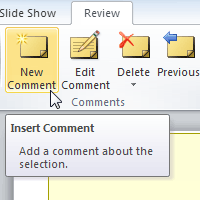
Before presenting your PowerPoint presentation, you might decide to ask someone else to look over it. The two of you might even collaborate on a presentation. If you were revising a hard copy of a report, you might add comments in the margins or compare your rough and final drafts side by side. You can also do these things in PowerPoint using the Comments and Compare features.
In this lesson, you will learn how to add Comments and Compare two versions of a presentation.
Reviewing presentations
Have you been asked to work with someone else to create a PowerPoint presentation? Or perhaps you've created a slide show and would like another person to view it to make sure everything looks polished. PowerPoint's Comments and Compare features make it easier for you to collaborate with others on the content of your presentation.
Commenting on presentations
When you are revising or collaborating on a presentation, you might want to make notes or suggestions without actually changing anything on the slide. Using comments allows you to take note of anything on a slide without altering the slide itself. Comments can be added and read by the original author or any other reviewers.
To add a comment:
- Select the text, or click on the area of the slide where you would like the comment to appear.
- Select the Review tab, and locate the Comments group.
- Click the New Comment command.
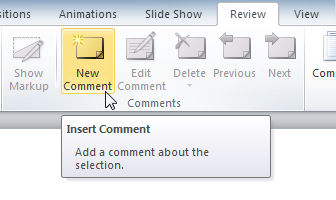 The Insert Comment command
The Insert Comment command - Type your comment.
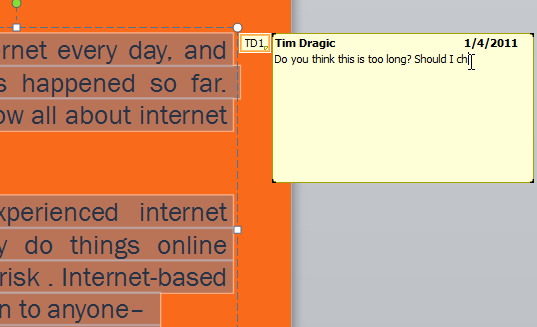 Typing a comment
Typing a comment - Click anywhere on the slide, and your comment will appear.
Added comments show up as small thumbnails rather than full-sized notes. To read a comment, just hover your mouse over the thumbnail.
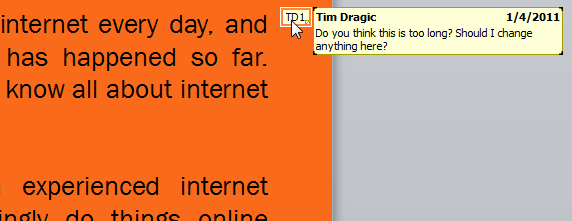 Hovering the mouse over the thumbnail to read the comment
Hovering the mouse over the thumbnail to read the commentTo edit a comment:
- Select the comment you would like to edit by clicking the comment thumbnail.
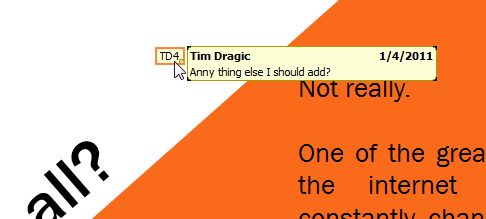 Selecting a comment to edit
Selecting a comment to edit - Click the Review tab.
- Click the Edit Comment command.
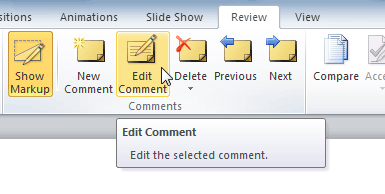 The Edit Comment command
The Edit Comment command - Make the desired changes.
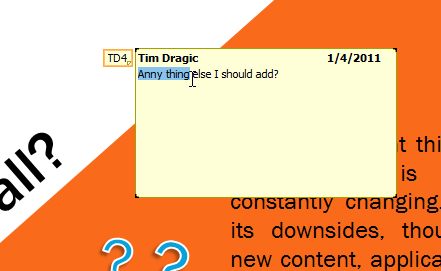 Editing a comment
Editing a comment - Click anywhere on the slide, and the comment will update to reflect your edits.
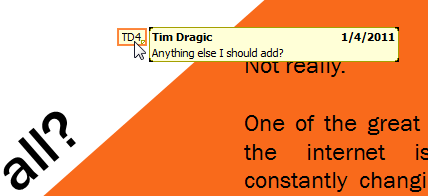 The edited comment
The edited comment
To respond to a comment:
- Right click the comment you would like to respond to.
- From the drop-down menu, select New Comment.
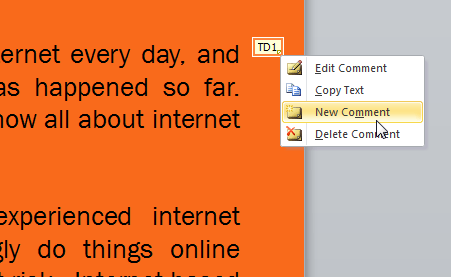 Responding to a comment
Responding to a comment - Type your comment.
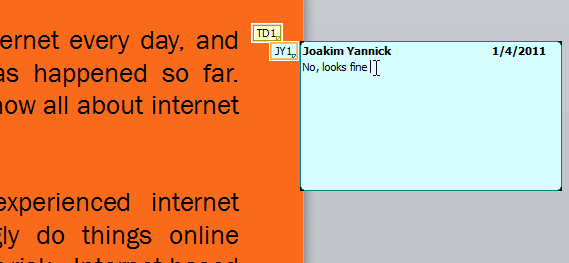 Typing the response
Typing the response - Click anywhere on the slide, and the new comment will appear below the original comment.
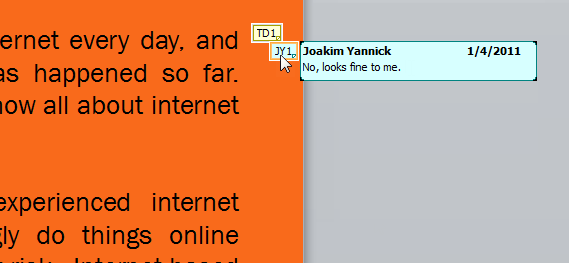 The original comment thumbnail and response
The original comment thumbnail and response
To delete a comment:
- Select the comment you wish to delete.
- From the Review tab, click the Delete command.
 The Delete Comment command
The Delete Comment command
To delete multiple comments, simply click the Delete drop-down arrow and select Delete All Markup in the Current Slide or Delete All Markup in the Current Presentation.
 Deleting all the comments in a presentation
Deleting all the comments in a presentationComparing presentations
If you are collaborating on a presentation or even just asking someone else to review your presentation, you might want to use the Compare feature. The Compare feature combines two versions of the same presentation. This allows you to see all of the differences between the two and decide which changes to include in the final version of your presentation.
To compare two presentations:
- Select the Review tab, and locate the Compare group.
- Click Compare. A dialog box will open.
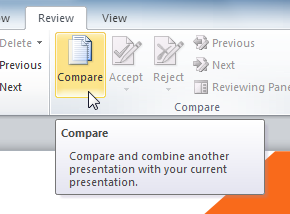 The Compare command
The Compare command - Browse for and select the desired file.
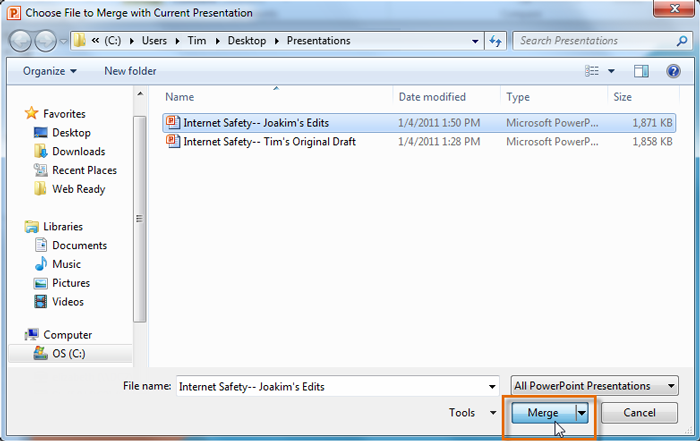 Browsing for the desired file
Browsing for the desired file - Click Merge.
- Click the buttons in the interactive below to learn how to review comments and changes using the Compare feature.
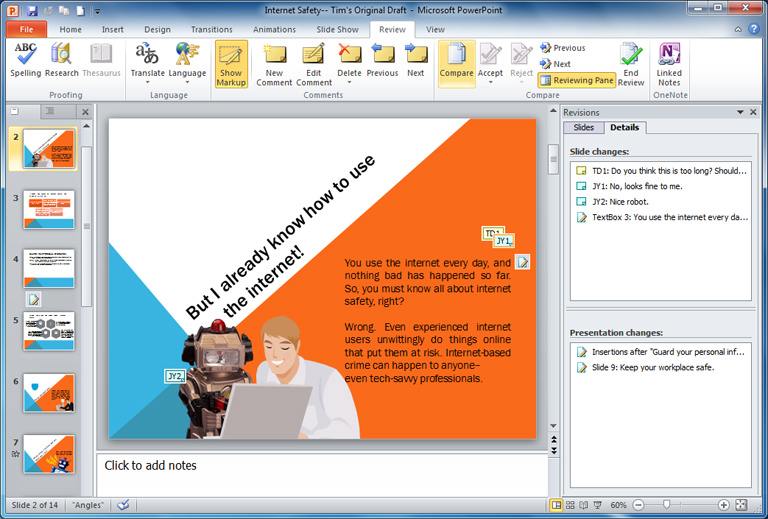
Reviewing comments
Compare also allows you to view Comments from the person who reviewed your presentation. To read a comment, click the comment thumbnail.
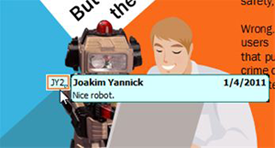
Reviewing Pane: Details Tab
In the Reviewing Pane, the Details tab lists every change that has been made to that slide, as well as all the comments. Click a change to see its location on the slide.
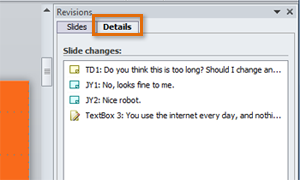
Reviewing Pane: Slides Tab
In the Reviewing Pane, the Slides tab lets you view the revised version of each slide. Click the slide to see a larger preview of what the revised slide will look like in your presentation, or click the checkbox to accept all revisions to the slide.

Accepting multiple changes
In addition to reviewing changes individually, you can also accept multiple changes at once. Click the Accept drop-down arrow and select either Accept All Changes to the Current Slide or Accept All Changes to the Presentation.
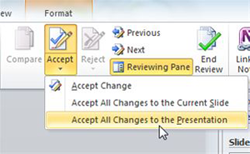
Next Change
Click Next to view the next change in the presentation. You can also click Previous to view the previous one.
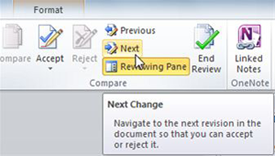
Compare
To Compare your presentation with another file, click Compare, then browse for and open the desired file.

Ending the Review
When you are satisfied with the changes you have accepted, click End Review. Only the changes you have accepted will show up in your presentation.

Reviewing changes on the slide
Click the revisions icon anywhere it appears on a slide to see the changes that have been made in that spot. Check the checkbox next to each revision you would like to accept. To reject a change, simply leave the checkbox unchecked.

Reviewing changes in the Slides tab
Some changes, like Inserted or Deleted slides, will show up on the Slides tab on the left. Click the revisions icon to see the change, and click the checkbox if you would like to accept it.

Using the reviewing features safely
If there are any comments in your presentation, you should remove them before sharing the final version with anyone you are not collaborating with. Comments can reveal confidential information that could lead to embarrassment or make you or your company appear unprofessional.
It's a good idea to double-check your presentation using the Document Inspector. The Document Inspector can tell you if there are any comments or other hidden data in your presentation that you may need to remove.
To use the Document Inspector:
- Save your presentation.
 Saving the presentation
Saving the presentation - Click the File tab to go to Backstage view.
- Select Info on the left side of the page.
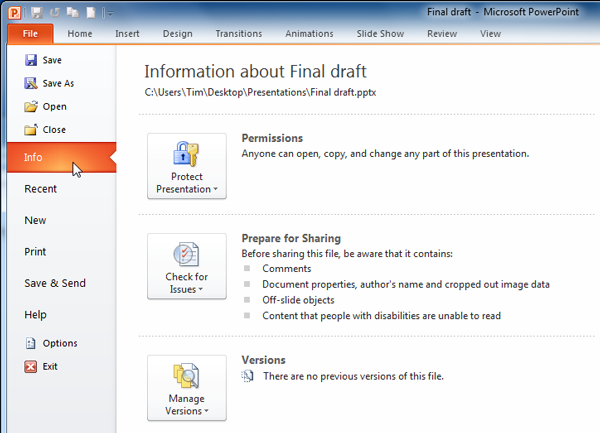 Viewing presentation information in the Backstage view
Viewing presentation information in the Backstage view - Click the Check for Issues command. A drop-down menu will appear.
- Select Inspect Document.
 The Check for Issues drop-down menu
The Check for Issues drop-down menu - Click Inspect.
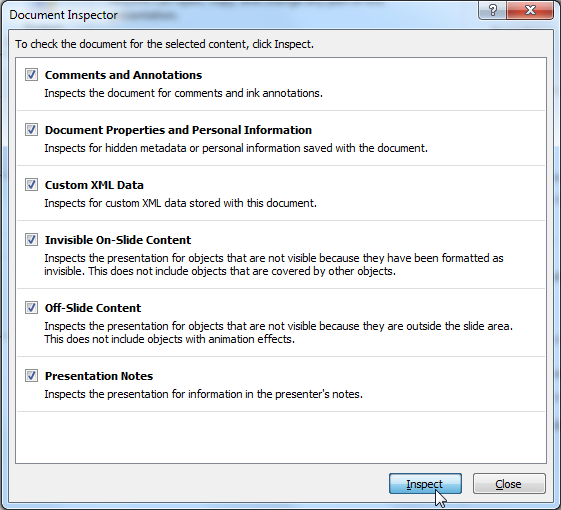 Starting the inspection
Starting the inspection - The inspection results will show an exclamation mark for any categories where it found possibly sensitive data, and it will also have a Remove All button for each of those categories. Click Remove All to remove the data.
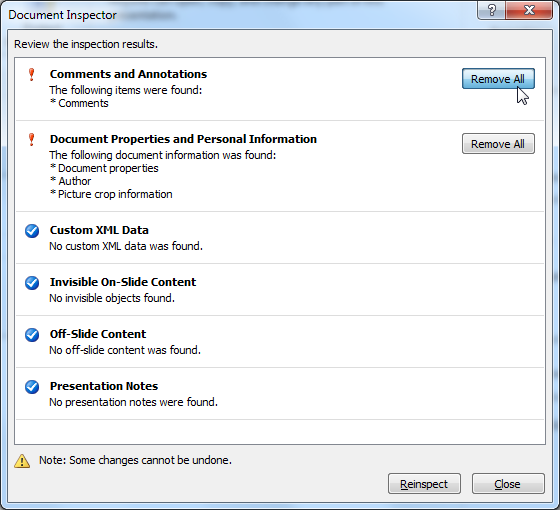 Removing potentially sensitive data
Removing potentially sensitive data - Close the dialog box when you're done.
- From Backstage view, click Save to make the changes permanent.
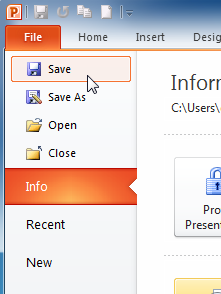 Saving the presentation in the Backstage view
Saving the presentation in the Backstage view
Challenge!
- Open an existing PowerPoint presentation. If you want, you can use this example.
- Select text on any slide, and add a comment.
- Edit the comment you just added.
- Delete all comments in the presentation.
- Run the Document Inspector to find and remove hidden data.



